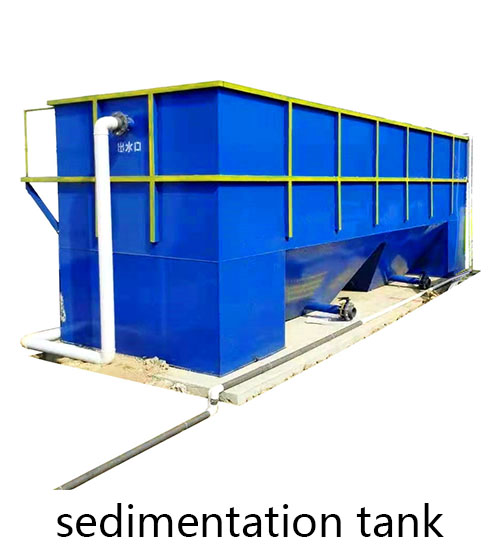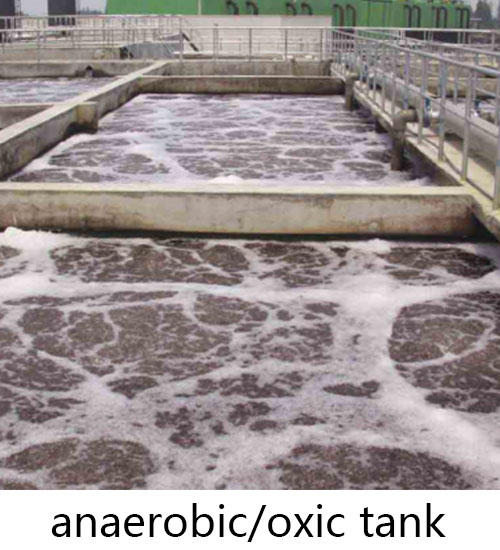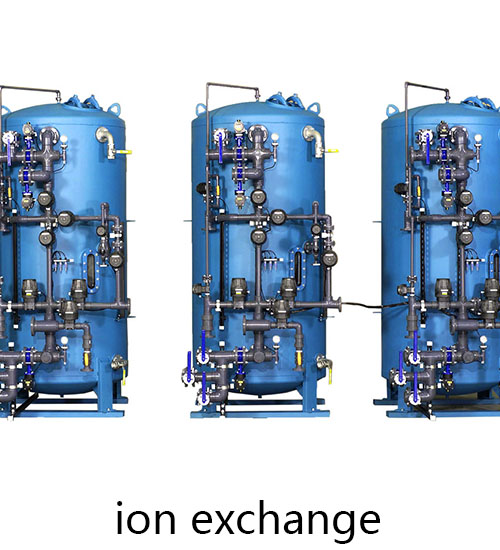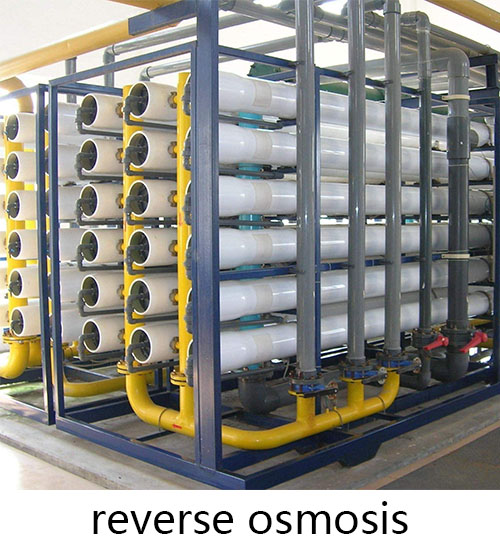متطلبات تصريف مياه الصرف الصحي للمحتوى الملحي:
1. مياه الصرف الصناعي: <800-1000 ملغم/لتر
2. مياه الصرف الصحي المنزلية: <150-200 ملغم/لتر
وفقًا ل TDS، يمكن تقسيم مياه الصرف الصحي إلى ثلاثة أنواع:
1. مياه الصرف الصحي عالية الملوحة للغاية (> 30000 ملغم/لتر من المواد الصلبة الصفرية)
2. مياه الصرف الصحي متوسطة إلى عالية الملوحة (2000-10000 ملغم/لتر)
3. مياه صرف صحي منخفضة الملوحة (500-2000 ملغم/لتر)
ما هي طرق تحلية المياه؟
1. الطرق الكيميائية: تتضمن إضافة عوامل كيميائية، مثل الكلوريدات والهيدروكسيدات، للتفاعل كيميائياً مع الأملاح في مياه الصرف الصحي لتقليل المحتوى الملحي. هذه الطريقة بسيطة وفعالة ولكن يمكن أن تؤدي إلى تلوث ثانوي وتكاليف معالجة أعلى.
2. الطرق البيولوجية: الاستفادة من عمل التحلل الذي تقوم به الكائنات الحية الدقيقة لتحليل المواد العضوية المحتوية على الملح إلى مواد قليلة الملح أو خالية من الملح. وتشمل الطرق البيولوجية الشائعة الحمأة المنشطة وطرق الأغشية الحيوية والمعالجة البيولوجية اللاهوائية. هذه الطريقة صديقة للبيئة وتكاليف المعالجة فيها منخفضة، ولكنها ذات دورة معالجة أطول وحساسة لنوعية المياه والعوامل البيئية.
3. الطرق الفيزيائية: تشمل الغسيل الكهربائي والتناضح العكسي والتبادل الأيوني. وتستخدم هذه الطرق الفصل الغشائي أو عوامل التبادل الأيوني لفصل الأملاح بشكل انتقائي عن مياه الصرف الصحي لتحقيق تحلية المياه. يمكن أن تحقق الطرق الفيزيائية تأثيراً عالياً في تحلية المياه، ولكن الاستثمار في المعدات وتكاليف الصيانة مرتفعة. خزانات الترسيب، والخزانات اللاهوائية الهوائية، والغسيل الكهربائي.



تطبيقات تحلية مياه الصرف الصحي
1. طريقة التبخير: يتم تبخير مياه الصرف الصحي عالية الملوحة عن طريق التسخين، مع ترك الملح في المادة الصلبة بعد التبخير. هذه الطريقة عالية الكفاءة وسهلة التشغيل، ولكنها تتطلب كمية كبيرة من الطاقة الحرارية والمساحة.
2. طريقة التبادل الأيوني: يستخدم راتنج التبادل الأيوني لتبادل الأيونات في مياه الصرف الصحي مع الأيونات الموجودة على الراتنج، بمعدل تحلية يزيد عن 90%. ومع ذلك، يجب استبدال الراتنج بانتظام، ويتطلب المحلول الملحي المركز بعد المعالجة مزيدًا من المعالجة.
3. طريقة التناضح العكسي: تخضع مياه الصرف عالية الملوحة للتناضح العكسي تحت ضغط عالٍ لفصل الأملاح والملوثات. كفاءة المعالجة عالية للغاية، ولكن تكلفة المعدات عالية ونفقات التشغيل باهظة الثمن.
4. تكنولوجيا التبلور بتركيز التبخير متعدد التأثيرات بدرجة حرارة منخفضة: تستخدم مبخرات متعددة مترابطة حيث يتم استخدام البخار الناتج عن إحدى المراحل كمصدر حراري للمرحلة التالية، مما يحقق استخداماً مرحلياً للطاقة ويقلل من استهلاك الطاقة. وفي النهاية، يفصل ذلك مياه الصرف الصحي عن الأملاح الصلبة، ويمكن إعادة المياه المحلاة إلى نظام الإنتاج لإعادة استخدامها.



ما هي تحديات تحلية مياه الصرف الصحي؟
1. تثبيط النشاط الميكروبي بسبب الملوحة العالية: تعمل مياه الصرف الصحي ذات الملوحة العالية على تثبيط نمو ونشاط الكائنات الحية الدقيقة بشكل كبير، مما يؤدي إلى جفاف الخلايا الميكروبية أو حتى موتها، مما يجعل من المستحيل تحلل المادة العضوية في مياه الصرف الصحي بشكل فعال. بالإضافة إلى ذلك، يمكن أن تتسبب الملوحة العالية أيضاً في تآكل معدات المعالجة وتلفها، مما يزيد من تكلفة الصيانة والاستبدال.
2. ارتفاع تكاليف المعالجة: لتقليل ملوحة مياه الصرف الصحي، من الضروري بشكل عام تخفيف مياه الصرف الصحي، مما يزيد من استهلاك المياه وتكاليف المعالجة في هذه العملية. بالإضافة إلى ذلك، تستهلك معالجة مياه الصرف الصحي عالية الملوحة الكثير من الطاقة الحرارية والكهربائية، مما يزيد من تكاليف المعالجة.
3. اختيار التكنولوجيا وإمكانية تطبيقها: تقنيات تحلية المياه المختلفة لها مزاياها وعيوبها. على سبيل المثال، تقنية الفصل الغشائي فعالة وصديقة للبيئة، لكن مواد الأغشية عرضة للتلوث وتتطلب التنظيف والصيانة الدورية؛ أما طرق التحليل الكهربائي فهي مناسبة لمعالجة مياه الصرف الصحي عالية الملوحة التي تحتوي على أيونات المعادن الثقيلة، ولكن استهلاكها للطاقة أعلى؛ أما طرق التبخير والتركيز فتستهلك طاقة عالية ومعدات معقدة؛ وتتطلب المعالجة البيولوجية وقتاً أطول للتفاعل البيولوجي. يجب الموازنة بين اختيار التكنولوجيا المناسبة والظروف الخاصة.
4. تعقيد تركيبة مياه الصرف الصحي: تحتوي مياه الصرف الصحي في حقول النفط والغاز على مواد عضوية وأملاح غير عضوية مختلفة، لكل منها خصائص كيميائية مختلفة وقابلية تحلل بيولوجي، مما يزيد من صعوبة الإزالة. وعلاوة على ذلك، يمكن أن تؤثر الشوائب مثل المواد الصلبة العالقة وأيونات المعادن الثقيلة في مياه الصرف الصحي على فعالية المعالجة.
ما هي مخاطر مياه الصرف الصحي عالية الملوحة؟
تتجلى المخاطر البيئية لمياه الصرف الصحي عالية الملوحة في المقام الأول في سمية الكائنات الحية الدقيقة وتآكل المعدات وتدمير النظام البيئي.
1. السمية للكائنات الحية الدقيقة: يمكن لتركيزات الملح العالية أن تزيد من الضغط الأسموزي، مما يؤدي إلى جفاف الخلايا الميكروبية وانفصال بروتوبلازم الخلية. يمكن أن تقلل تأثيرات التمليح من نشاط نازعة الهيدروجينيز، كما أن زيادة تركيز أيون الكلوريد يمكن أن تكون سامة للبكتيريا. وبالإضافة إلى ذلك، تزيد تركيزات الملح المرتفعة من كثافة مياه الصرف الصحي، مما يسهل على الحمأة المنشطة أن تطفو وتضيع، مما يؤثر بشكل خطير على فعالية تنقية أنظمة المعالجة البيولوجية.
2. تآكل المعدات: يمكن للأملاح الموجودة في مياه الصرف الصحي عالية الملوحة أن تتسبب في تآكل الأنابيب والمعدات، مما يؤثر على عمرها الافتراضي وجودة خدمتها. على سبيل المثال، يمكن أن تؤدي تركيزات الأملاح المرتفعة بشكل مفرط إلى تآكل الأنابيب والمعدات، مما يؤثر على تشغيلها وصيانتها بشكل طبيعي.
3. تدمير النظام الإيكولوجي: يمكن أن يكون للملوثات مثل المواد الصلبة العالقة والمواد العضوية والمعادن الثقيلة والمواد الكيميائية الضارة في مياه الصرف الصحي عالية الملوحة تأثير كبير على البيئة والنظم الإيكولوجية. هذه المواد ليس لها تأثيرات سامة على الكائنات الحية الدقيقة فحسب، بل يمكن أن تتراكم أيضاً من خلال السلسلة الغذائية، مما يؤثر في نهاية المطاف على توازن وصحة النظام البيئي بأكمله.

ما هي أهمية تحلية مياه الصرف الصحي؟
1. حماية البيئة: إذا تم تصريف المحتوى الملحي في مياه الصرف الصحي دون معالجة، فقد يتسبب ذلك في تلوث خطير للبيئة. يمكن للملح أن يغير الخصائص الكيميائية للمسطحات المائية، مما يؤثر على بقاء الكائنات المائية على قيد الحياة، مما يؤدي إلى تصلب المياه والتخثث. يمكن أن تؤدي معالجة تحلية المياه إلى إزالة الأملاح من مياه الصرف الصحي بشكل فعال، مما يقلل من الضرر البيئي.
2. إعادة الاستخدام وإعادة التدوير: العديد من الأملاح الموجودة في مياه الصرف الصحي هي موارد قيّمة؛ على سبيل المثال، يمكن استخدام الأملاح الموجودة في بعض مياه الصرف الكيميائي لإنتاج كبريتات الصوديوم وكلوريد الصوديوم ومواد كيميائية أخرى. ومن خلال معالجة تحلية المياه، يمكن استخلاص هذه الموارد القيمة، مما يحقق الاستفادة من موارد مياه الصرف الصحي.
3. استيفاء معايير التصريف: لدى العديد من البلدان والمناطق معايير تصريف صارمة لمحتوى الملح في مياه الصرف الصحي. وللوفاء بمعايير التصريف، فإن معالجة تحلية المياه ضرورية لتقليل محتوى الملح في مياه الصرف الصحي إلى أقل من التركيز المحدد، مما يضمن إمكانية تصريف مياه الصرف الصحي بأمان في البيئة.
4. تجنب تآكل المعدات وتكلسها: يمكن أن يؤدي محتوى الملح في مياه الصرف الصحي إلى تآكل المعدات وخطوط الأنابيب، مما يقلل من عمرها الافتراضي. يمكن أن تؤدي معالجة تحلية المياه إلى إزالة الأملاح من مياه الصرف الصحي، مما يقلل من تآكل المعدات وتكلسها، وبالتالي إطالة عمرها الافتراضي.
5. منع تلوث التربة والمياه الجوفية: يمكن أن تؤدي التركيزات العالية من الأملاح والمواد غير العضوية القابلة للذوبان في مياه الصرف الصحي إلى تملح التربة وتلوث المياه الجوفية إذا تم تصريفها مباشرة أو تسربت إلى التربة والمياه الجوفية. يمكن أن تقلل معالجة تحلية المياه من مخاطر تلوث التربة والمياه الجوفية.
6. حماية النظم الإيكولوجية: يمكن أن يؤدي تصريف مياه الصرف الصحي في المسطحات المائية الطبيعية إلى زيادة تركيز الأملاح، مما يخل بتوازن النظم الإيكولوجية المائية ويؤثر على بقاء وتكاثر الكائنات المائية. من خلال معالجة تحلية المياه، يمكن الحد من التأثير السلبي لمياه الصرف الصحي على النظم الإيكولوجية المائية، وحماية التنوع البيولوجي والتوازن البيئي في المسطحات المائية.

